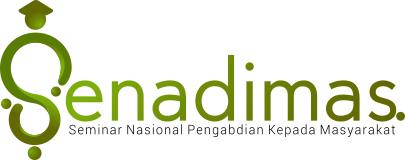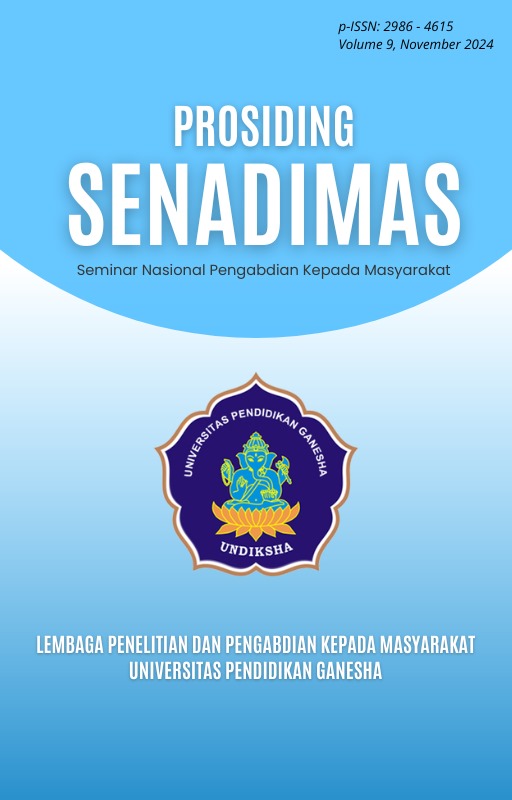PELATIHAN PENERAPAN MICROLEARNING INVESTIGATIF SECARA FLEKSIBEL MENGGUNAKAN TEMPLATE HYPERDOCS
Kata Kunci:
investigative microlearning, self-contained, hyperdocs template, flexible presentation organizationAbstrak
Pelatihan microlearning investigatif (MLI) dengan fasilitas video klip eksperimental ini bertujuan untuk memperkuat keterampilan ilmiah bagi guru dan siswa di era kemajuan teknologi informasi dan semakin meningkatnya kebutuhan akan program mobile learning yang harus tangguh dalam lingkungan aplikasi kecerdasan buatan (AI). MLI berupa perangkat belajar lengkap dengan organisasi presentasi yang fleksibel menggunakan templat hyperdocs. Materi pelatihan terdiri dari sepasang MLI dengan penalaran induktif dan deduktif serta tiga MLI yang berkaitan erat dengan penalaran induktif. Masing-masing MLI dibagi menjadi beberapa dokumen, yaitu LKPD dengan sejumlah tautan dokumen pendukung, teks materi pembelajaran afirmatif sesuai isi tugas pada LKS, serta tugas dan penilaian penguasaan konsep. Pelatihan dilaksanakan tiga kali dalam tiga minggu yaitu satu kali pada minggu pertama secara offline di mana guru sendiri didampingi Tim Pelaksana berlatih mengisi LKPD kemudian pada hari lain mencoba menerapkan sendiri kepada siswa di kelas. Kemudian pada minggu ke-2 dan ke-3 dilakukan pendampingan melalui zoom meeting untuk mengatasi kemungkinan permasalahan yang ditemui dalam pelaksanaannya di kelas. Pelatihan terlaksana dengan lancar dan mendapat apresiasi yang tinggi dari para peserta. Ada peserta yang meminta diberikan video klip untuk menunjang materi pembelajaran lainnya seperti Kesetimbangan Kimia.
Referensi
Sudria, I.B.N. Redhana, I. W. 2023. Sains - micro learning ilmiah induktif dan deduktif berbantuan video eksperimen. Singaraja: Undiksha Press.
Bruck, P. A. (2006). Hug, T., Linder, M. & Bruck, P.A (editors). What is Microlearning and why care about it? (Introductory Note). Proceedings of Microlearning conference, 7-10.
Hug, T. (2006). Hug, T., Linder, M. & Bruck, P.A (editors). Micro Media & eLearning 2.0 (Introductory Note). Proceedings of Microlearning conference, 11-16.
Leene, A. (2006). Hug, T., Linder, M. & Bruck, P.A (editors). Micro Content is Everywhere (On Microlearning). Proceedings of Microlearning conference, 20-40.
Rutherford, F. J. and Ahlgren A.. (1990). Science for All Americans. New York: Oxford University Press.
American Association for the Advancement of Science (AAAS). (1993). Benchmarks for Science Literacy: Project 2061. New York: Oxford University Press.
National Academy of Science. (1996). National Science Education Standards. Washington DC: National Academy Press.
Colander, D., & Hunt, E. (2019). Social Science: An Introduction to the Study of Society (17th ed.). New York: Routledge.
Martin-Hansen, L. (2002). Defining Inquiry. The Science Teacher, 69, 34–37.
NQS (The National Quality Standard). (2011). Inquiry-based learning. NQS PLP e- Newsletter No.45 2012.
Cuzzolino, M.P. (2019). Experiences of Transformative Awe and the "Small Self" in Scientific Learning and Discovery. Doctoral dissertation, Harvard Graduate School of Education. http://nrs.harvard.edu/urn-3:HUL.InstRepos:42081562
Edmund, N. W. (2005). Report on the relationship of the scientific method to scientifically valid research and education research. National Board for Education Sciences.
Kolb D. (1984). Experiential Leaming: Experience as the Source of Learning and Development. Englewood Cliffs, New Jersey: Prentice Hall.
OECD. (2016). PISA 2015 Results – Excellence and Equity in Education. Volume 1. Retrieved March 5, 2017 from http:/www. pisa.oecd.org.
OECD. (2019). PISA 2018 Assessment and Analytical Framework. Available at. https://www.oecd.org/education/pisa-2018-assessment-and-analytical-framework-b25efab8-en.htm
Thomond, P.N. (2004). Exploring and Describing Management Action for the Pursuit of Disruptive Innovation. PhD Thesis. Cranfield University. dspace.lib.cranfield.ac.uk/...ThomondThesis.pdf.
Wieman, C., & Gilbert, S. (2015). Taking a Scientific Approach to Science Education, Part I– Research. Microbe. 10(4), 152-156.
Roche, R.A.P. Mullally, S.L. McNulty, J.P. Hayden, J. Brennan, P. Doherty, C.P. Fitzsimons, M. McMackin, D. Prendergas, J. Sukumaran, S. Mangaoang, M.A. Robertson, and O'Mara, S.M. (2009). Prolonged rote learning produces delayed memory facilitation and metabolic changes in the hippocampus of the ageing human brain. BMC Neuroscience. Pp. 1-17.
Hayat, F. Ahmad, S. Kousar, N. Badshah, Gul, N. (2023). Factors Responsible For Promoting Rote Learning Among Students At Tertiary Level. Journal of Positive School Psychology. 7 (5): 324-335
Adam, L. (1938). Five Methods of Serial Rote learning. New York: Archives of Psychology (R.S. Woodworth – Editor No. 221). Pp: 1-67. in Forgotten Boos (2016 FB &c Ltd.). www.forgottenbooks.com
Friesen, N. (2006). Hug, T., Linder, M. & Bruck, P.A (editors). Microlearning and (Micro) Didactic (On Microlearning). Proceedings of Microlearning conference, 41-61.
Linder, M. (2006). Hug, T., Linder, M. & Bruck, P.A (editors). Learning in Micro Media Environments? (Introductory Note). Proceedings of Microlearning conference, 17-19.
Young, X. (2018). A Study on the Mode of Data Structure by Micro Learning Based on Smart Phones. Advances in Computer Science Research, volume 83, 286-290.
Butcher, Davis, & Highton, 2006; Cuzzolino, Grotzer, Haris, & Weissbourd, 2019. Module design
Silberberg, M.S. (2010). Principle of General Chemistry 2nd edition. New York: The McGraw-Hill Companies, Inc
Sudria, I. B. N. (2016). Pengembangan Perangkat Pembelajaran Ilmiah dengan Penalaran Dasar Induktif dan Deduktif. in A. Premono, I. W. Sugita, R. Sukarno, & M. A. Akbar (Eds.). Proseding Konaspi VIII, 731–740. Jakarta: Universitas Negeri Jakarta.
Stepp, R.E. (ND). Concepts in conceptual clustering. Coordinated Science Laboratory University of Illinois at Urbana-Champaign Urbana. IK 61801. Available at https://www.ijcai.org/Proceedings/87-1/Papers/042.pdf
Handa, V. C. & Talisayon, V. M. (2023). Practical problem-solving tasks for meaningful learning and retention in college chemistry for pre-service teachers. European Journal of Science and Mathematics Education, 11(4), 702-716
Bassham, G. Irwin, W. Nardone, H. & Wallace, J.M. (2008). Critical Thinking - A Student’s Introduction. New York: Mc Graw Hill.
Felder, R. M. & Silverman L.K. (1988). Engr. Education, 78(7), 674–681.
Prince, M.J. & Felder (2006). Inductive Teaching and Learning Methods: Definitions, Comparisons, and Research Bases. J. Engr. Education, 95(2), 123–138 (2006)
Nuhoğlu, H. (2020). The Effect of Deduction and Induction Methods Used in Modelling Current Environmental Issues with System Dynamics Approach in Science. Participatory Educational Research (PER) 7(1): 111-126.
Siswono, T.Y. Hartono, S. & Kohar, A.W. (2020). Journal on Mathematics Education
(3): 417-438
Toumi, I. (2018). The Impact of Artificial Intelligence on Learning, Teaching, and Education, JRC Science for Policy Report (Eds: Cabrera, M. Vuorikari, R. & Punie, Y.). European Commission.
Education Policy UNESCO Education Sector. (2019). Artificial Intelligence in Education: Challenges and Opportunities for Sustainable Development - UNESCO Education Sector - Working Paper on Education Policy - The Global Education 2030 Agenda. Place de Fontenoy – Paris: the United Nations Educational, Scientific and Cultural.
Liu, Y. Saleh,S. & Huang, J. (2021). Artificial Intelligence in Promoting Teaching and Learning Transformation in Schools. International Journal of Innovation, Creativity and Change. 15 (3): 891 - 902
Sudria, I.B.N. (2014).Asesmen Kebutuhan Pengembangan Perangakat Pembelajaraan Induktif dan Deduktif Ilmiah. Seminar Nasional MIPA IV UNDIKSHA 2014.
Unduhan
Diterbitkan
Terbitan
Bagian
Lisensi
Hak Cipta (c) 2024 Seminar Nasional Pengabdian kepada Masyarakat

Artikel ini berlisensiCreative Commons Attribution-ShareAlike 4.0 International License.



